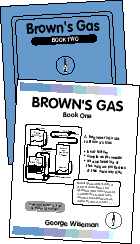WELD IT WITH BROWN’S GAS!
Glass
Brown’s Gas works great to weld glass in exactly the way you would expect a gas torch to do the job. There’s not much else to say as it’s a perfect application of Brown’s gas to join in the same way other gas-based glass welding works.
Quartz
Brown’s Gas works very well on quartz, actually better than anything I’ve seen. Quartz requires very high energies to melt it. Anyone working with quartz should look into this gas. This would be a low cost alternative to the traditional use of liquid hydrogen and oxygen.
A company I know in Colorado uses $100,000 worth of liquid hydrogen and oxygen a month to make quartzware. With Brown’s Gas the cost of the fuel would be cut by at least 75% and the storage of pure water is a lot easier than the cyrogenic temperatures of liquid hydrogen and oxygen. Further, there would be no transportation danger (of the fuel). And Brown’s Gas has up to 3.8 times more energy potential than conventional di-atomic gas, so you get more work done with a smaller flame.
Cast Iron

A welding torch (#3 tip) was able to make a nice puddle and easily welded cast iron. I was just melting it together with no flux of any kind using cast iron welding rod, using the puddle method. I then took the glowing cast iron that I’d just welded and DUMPED it into water (room temperature). It DID NOT BREAK. After it had cooled down, I broke it to look at the weld; it looked perfect! I couldn’t see a difference between crystal structure of the weld and the ‘parent’ metal.
BROWN’S GAS BOOK ONE
A basic guide to Brown’s Gas including a brief history, Brown’s Gas theory and an explanation of some of its unique properties, plus Eagle-Research experiments that prove Brown’s Gas viability

BROWN’S GAS BOOK TWO
A comprehensive How-To Brown’s Gas Manual. Build a high quality Brown’s Gaselectrolyzer that will exceed the performanceof ANY known commercial machine to date.
Copper
The Brown’s Gas easily welds copper, using plain copper rod, no flux. I just used the “puddle” method. Copper sheds it’s heat so quickly though that you need a fairly good sized flame, and/or insulate the areas of the copper that you are not actually welding. The surface of the copper turns black (copper di-oxide) but otherwise seems great! Di-oxide brushes off.
Aluminum

I have gotten excellent welds with aluminum, using the type of rod that has the flux inside it. Again, the Brown’s Gas provides so much energy in a pin-point fashion that welding aluminum is easier than using oxy./acet.
